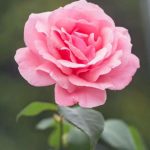 An axis bearing one or more pistils (a pistillate flower) or one or more stamens (a staminate flower) or both (a perfect flower), often with parts to make it more functional or more attractive to pollinators (e.g. sepals, petals or rewards such as nectar).
An axis bearing one or more pistils (a pistillate flower) or one or more stamens (a staminate flower) or both (a perfect flower), often with parts to make it more functional or more attractive to pollinators (e.g. sepals, petals or rewards such as nectar).
An axis bearing one or more pistils or one or more stamens or both.
The reproductive stem of the angiosperms. Typically it is made up of a calyx of sepals, a corolla of petals, an andrecium of stamens and a gynecium of carpels.
This word comprises the organs of reproduction and their envelope.
The parts of a flowering plant (angiosperm) that carry out sexual reproduction. Female flower parts include the stigma, style, and ovary, (which contains ovules that develop into seeds). Collectively, these parts are called the pistil. Male parts are the filament (anther stalk) and the anther (which contains pollen that produces sperm cells). Collectively, the male parts are termed the stamen. Petals and sepals are accessory structures, which may or may not be present. The top of the flower stalk is often expanded and may become part of the fruit. (Compare gymnosperms, ferns).
The reproductive parts of a seed plant.
Egg-or conical-shaped cluster of blooms on cannabis plants that grow up to several inches long. Sometimes referred to as bud or nug.
The organ of reproduction, basic in determining to what genus and species the plant belongs. They are normally composed of three parts: the calyx, the corolla, and the sexual organs proper, the male stamens and the female carpels. Not all may be present in any given flower (clematis, for instance have no petals), and they may be, as in orchids or cannas, modified into the most fantastic forms.
A movement of liquid or gas.
The amount of liquid or gas which is moving.
The reproductive organs of flowering plants, which comprise the most prevalent and thriving group in the plant kingdom. Typically, these structures are vibrant and brightly colored to entice insects for pollination, ensuring the fertilization of their seeds.
